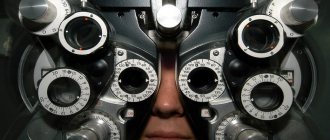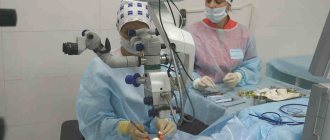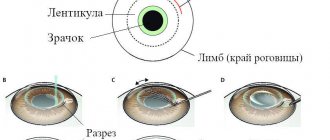“Just before the New Year, I had laser vision correction and got rid of glasses, hopefully for the next couple of decades,” says Olga Kashubina, medical journalist, author of the ShBmnk telegram channel, a graduate of the Krasnoyarsk State Medical University.
Source: Zozhnik
Today this operation will not surprise anyone - many of my friends had this done a few years ago, others are thinking about it in the near future. There are dozens of clinics in Russia offering to get rid of myopia, farsightedness or astigmatism in a few minutes (and several tens of thousands of rubles). But the benefits, risks and consequences of such operations are not obvious to everyone.
LASIK and SMILE
SMILE appeared only 4 years ago, so it is possible to compare the effectiveness of methods only over a short distance. In a nutshell, there is no difference between LASIK and SMILE in terms of safety or effectiveness, but after SMILE, patients recover a little faster and are less likely to suffer from dry eye syndrome. (But the price of SMILE is about 1.5-2 times more expensive than LASIK - Zozhnik’s note).
In fact, the new method is less traumatic for the cornea, so it can be assumed that the risk of delayed complications will also be lower. But it’s too early to guess. You can read more here and here (in English).
And here a nice guy explains the essence of LASIK and SMILE operations on video (there are subtitles):
By the way, the world's first successful laser surgery to treat myopia was carried out in the Soviet Union. This happened more than 40 years ago, and her technique is constantly being improved. However, some patients are confused by the fact that many ophthalmologists are in no hurry to say goodbye to glasses, and some even dissuade their patients from interventions of this kind.
Complications of LASIK
Possible complications after LASIK are also divided into several groups:
1. Side effects of the recovery period that do not affect the result of the operation:
- Damage to the superficial layers of the cornea by the eyelid dilator
- Temporary ptosis of the upper eyelid
- Debris
- Damage to the epithelial layer during flap formation
- Consequences of marking - coloring of the subflap area
- Mild form of dry eye syndrome
- Partial keratomalacia (flap resorption)
- Epithelial ingrowth under the corneal flap
2. Postoperative complications requiring intensive conservative or surgical treatment:
- Keratitis
3. Postoperative complications requiring repeated surgery:
- Incorrectly placed flap
- Undercorrection/overcorrection
- Turning the patchwork edge
- Decentration of the optical zone
- Flap displacement
- Debris in the center of the optical zone, reducing visual acuity
- Ingrowth of epithelial tissue under the corneal flap with discomfort and decreased vision
- Traumatic flap injuries
In addition, complications of LASIK include surgeon errors when creating a corneal flap (torn, decentered, incomplete, thin, small, with a full cut, with striae). Such complications require the use of alternative treatment methods.
Advantages of laser vision correction
Let me start with the fact that correcting vision surgically is convenient from a practical point of view: in the long run it is cheaper than buying lenses, and glasses tend to break and fail, and laser correction costs only 2-3 good frames with glasses . And even if you are comfortable with glasses, there are many situations in which they interfere: sports, communication with babies, travel, frost outside.
Once on vacation, I foolishly went swimming with my glasses on, and they were washed off my nose by a wave. The rest of the day on the beach was spent searching and gloomily thinking about how to survive until the end of the trip. It is clear that such situations are rare, but in general, glasses as a medical accessory, and not as an element of style, are a bit of a crutch that limits freedom. Again, chameleon lenses are not always beautiful, and in the sun, your eyes generally need to be protected from ultraviolet radiation, just like your skin. It turns out that people with glasses have a higher risk of melanoma and photokeratitis.
It is important to understand that neither surgery, nor glasses, nor daytime lenses actually treat myopia as a disease, but correct its stabilized consequences. Just like plastic surgery, peeling or foundation does not cure acne, but can make facial scars invisible. Therefore, from the point of view of medical effect, all these approaches to vision correction have the same effectiveness: to make you see normally here and now.
It is for this reason that laser correction is not performed on patients with progressive myopia. And it is logical that it is not paid for by the state: formally, it is still cheaper to give you discounted glasses for 100 rubles than to refer you to ophthalmic surgeons. That is, you need to perceive such an operation primarily as aesthetic, and not as therapeutic. And if you feel good wearing glasses, there is no reason to give them up.
In fact, there are no significant reasons for alarm: for example, the risk of losing vision due to post-operative infection is lower than when wearing contact lenses . The likelihood of developing other complications, provided that the condition of your eyes is thoroughly diagnosed BEFORE the procedure, also does not exceed 0.5% for each individual problem, and almost all of them are temporary or reversible.
In short, 95.5% of the patients surveyed do not regret having decided to undergo surgery. And ophthalmologists wearing glasses - well, firstly, many of them are conservative older people for whom the technology still seems not reliable enough, and secondly, laser correction is not suitable for everyone and not for all vision problems, but - third, no one knows what percentage of ophthalmologists once got rid of glasses thanks to refractive surgery.
Laser correction is a technological miracle in terms of effectively eliminating a medical problem. Just as a dentist can replace a lost tooth with an implant in one day , and a cardiac surgeon can replace a vessel clogged with plaque with a stent or prosthesis, ophthalmic surgeons make sure that, in the optimal scenario, you will forever forget about a significant physical limitation. Without any difficult efforts of will on your part, a long recovery period, or the need to tighten something up once a year. A few hours in the clinic, then a few hours to rest - and here it is, a brave new world to the very horizon.
There are studies about the long-term consequences of different types of operations (in English). Read here and here.
Complications of PRK
Any complications with PRK, according to the degree of negative impact on vision, are divided into:
1. Side effects of the recovery period that do not affect the result of the operation:
- Corneal edema
- Extension of the re-epithelialization period
- Filamentous epitheliokeratopathy
- Temporary ptosis of the upper eyelid
- Mild form of dry eye syndrome
- Allergic reaction to the use of drugs
2. Postoperative complications requiring intensive conservative or surgical treatment:
- Herpetic or bacterial keratitis
- Mild form of subepithelial fibroplasia (corneal opacification)
- Severe form of dry eye syndrome
3. Postoperative complications requiring repeated surgery:
- Ablation zone displacement
- Severe corneal opacity (haze)
- Incomplete removal of epithelium
- Hypercorrection for myopia
- Deterioration of refractive effect
- Undercorrection
Features of the event
The operation will not take much time for the patient. It usually lasts within ten minutes. The manipulation is carried out in stages:
- The patient is given eye drops containing an anesthetic.
- To prevent blinking, a speculum is inserted between the eyelids.
- For subsequent extension of the flap, a suction ring is installed on the cornea area.
- The patient is asked to focus his gaze on the luminous point. This allows you to fix the eye in the desired position.
- Using a keratome, the layer of the cornea is separated, after which it is bent to the side.
- The laser beam acts on the exposed surface of the cornea.
- At the end, the bent part of the cornea returns to its original place.
- A rinsing solution and anti-inflammatory drops are instilled into the eyes.
There is no pain during the procedure itself, but patients may experience minor pain after the operation. If discomfort interferes with leading a full life, the doctor may prescribe anesthetic drops.
The operation is carried out using modern equipment
Complications of ReLEx Smile
It is worth noting that laser vision correction ReLEx Smile has the least complications in the postoperative period, because its technique differs significantly from somewhat outdated traditional methods. Complications observed with this technique are divided into:
1. Reversible, not subsequently affecting visual acuity:
- Loss of vacuum during surgery
- Photophobia
- Emerging halo effects
- Mild form of dry eye syndrome
2. Postoperative complications requiring intensive conservative treatment:
- Keratitis (diffuse lamellar)
3. Postoperative complications requiring repeated surgery:
- Incomplete lenticule extraction
- Undercorrection/overcorrection
- Diplopia
- Tear of the edge of the incision
- Keratoectasia
The following is a description of the most serious consequences of laser vision correction.
Treatment of photophobia.
The best treatment for photophobia is to address the underlying cause. When the irritating factor can be treated, photophobia disappears.
If you develop photophobia while taking the drug, you need to talk to your doctor about changing this drug.
If you have genetically light eye color, avoid bright sunlight and other harsh light, wear caps, hats, and sunglasses.
Photochromic lenses (chameleon lenses) are another way to reduce sensitivity to bright light. These lenses darken automatically in light and block 100 percent of ultraviolet radiation.
You can also use polarized lenses to block out bright light. It will provide additional protection from reflected light from water, sand, snow, and road asphalt.
In exceptional cases, it may be necessary to wear prosthetic lenses that are specially colored to match the color of a person’s own eyes. Prosthetic lenses reduce the amount of light entering the eye, making vision more comfortable.
Preparation and planning
The main goal of preparation is to eliminate contraindications to excimer laser correction. At least a week before a planned operation, patients who use contact lenses must abandon such optics. This is due to the fact that corrective devices have a mechanical effect on the cornea. To determine the parameters of the cornea as accurately as possible, time is required for its adaptation.
It is better to notify an ophthalmologist about the presence of existing chronic processes. Immediately before the procedure, you should not apply makeup or use any cosmetic products.
You will need to take sunglasses with you to the clinic, as there will be increased sensitivity to light in the first few days. Motorists should take into account the fact that they will not be able to drive for several days after the operation. Traveling by public transport is also not recommended due to the risk of infection.
How is the operation performed?
| Advantages | Flaws |
| Applicable to all types of visual impairments | Age restriction: not available under 18 years of age |
| Safety and non-traumatic | Does not prevent senile farsightedness |
| Quick tangible results | Not applicable for glaucoma, retinal abnormalities, cataracts |
| No pain | There are risks during pregnancy and breastfeeding |
| Performed under local anesthesia | Re-correction may be necessary |
| The duration of the procedure is no more than 20 minutes | Expensive |
| Possibility of correction on one or two eyes at once | Complete stabilization of vision - more than six months |
| No need for postoperative hospitalization | Any injury to the visual organ is subsequently suffered in a more severe form |
| Fast post-operative recovery | There is a small chance of pathology regression |
| A quick return to normal life |
- pain;
- adhesion of the eyelid and mucous membrane;
- sensation of a foreign object;
- burning sensation;
- fog in the eyes.
The patient lies horizontally on the couch. The entire procedure takes place under local anesthesia with pain-relieving drops and lasts 20-30 minutes, where the direct laser exposure takes no more than one minute. Stages of implementation:
- First of all, it is necessary to fix the eye using a vacuum ring. After treating the eye with special solutions, when the connection between the corneal epithelium and Bowman's membrane weakens, the operation itself can be performed.
- Using a cutting instrument - a keratome or a femtosecond laser, a flap of the corneal surface is formed, attached on one side to the cornea. It is put aside, as if turning the page of a book.
- The laser beam acts on the cornea, evaporating its deep layers and changing its shape according to the measured parameters of the patient.
- The flap returns to its original position, fixed without seams due to the collagen of the organ itself, and holds firmly, healing without scars.











